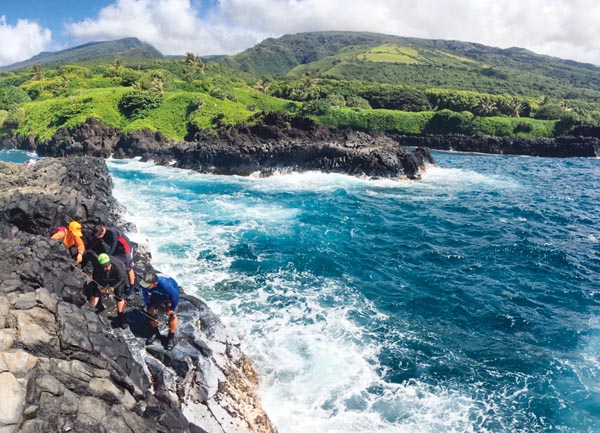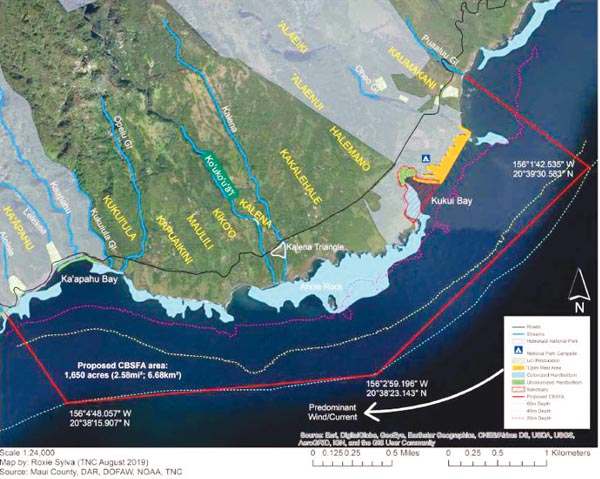Group is trying to regulate harvesting as resources have declined over years
Dakota Grossman, Staff Writer, dgrossman@mauinews.com

Local fishermen, divers, cultural practitioners and state agencies are getting much closer on a proposed set of boundaries and fishing regulations in Kipahulu.
To address poor fishing practices, increased foot traffic and depleting resources in East Maui, nonprofit Kipahulu Ohana had proposed to designate Kipahulu Moku nearshore waters as a Community-Based Subsistence Fishing Area, which would cover 5.7 miles of coastline from Kalepa Gulch to Pua’alu’u Gulch and stretch out to 60 meters in water depth.
“The goal for this whole CBSFA is, Kipahulu just wants to have more fish, you get more fish for fishermen to enjoy and the ohana can live off the ocean like they have been through several generations,” said Adam Wong, education specialist from the state Department of Land and Natural Resources’ Division of Aquatic Resources during a virtual community meeting Tuesday night.
Kipahulu Moku is about 12,000 acres, an area in East Maui full of families who have continued traditional but modernized fishing, farming and hunting.
Years of unsustainable fishing practices, such as collecting fish, limu and ‘opihi out of season; taking more than is needed and available; or hunting undersized species has depleted Kipahulu’s natural resources.

“Overharvest is considered to be one of the largest threats to nearshore marine ecosystems, while land-based pollution and coastal development also pose significant harm,” according to the management plan for the area.
Wong said the nonprofit approached DAR to help “protect and manage their resources.”
If approved by the state, the updated Hawaii Administrative Rules would establish new bag limits, size limits, seasonal closures/extensions for spawning for some fish and gear restrictions for kala, ‘omilu, moi, kole, ulua, ‘opihi and limu.
The changes would also establish a sanctuary in Kukui Bay, meaning having a no-take and no-vessel zone (unless for emergency) in the innermost section of the bay from Maka’aikuloa Point to Puhilele Point; prohibit take while night diving and scuba spearfishing for most species, but not all; and prohibit commercial take of akule.
“There were some concerns about closing the bay,” said Wong, who reassured that the map is not “set in stone” and encourages the community to collaborate on what boundaries would be best to satisfy safety concerns, mitigate trail erosion while accessing the bay and reduce overfishing habits.
Even if an individual catches fish outside of Kukui Bay but swims through the bay to exit the water, for example, that would still be a violation, according to DAR.
Kipahulu Ohana chose Kukui Bay to be a sanctuary because it’s “one of the most biologically diverse areas” in the moku, Wong said.
An ‘opihi rest area (no-take zone) is next to the proposed sanctuary fronting the Haleakala National Park campground, stretching from ‘Ohe’o to Maka’aikuloa Point.
Due to some pushback from the community, DAR might make some compromises to move the boundaries a little more in or to open up some boundaries in the opihi rest area, said Wong.
All in all, the regulations proposed for fish, lobster and other species, which would apply to each person per day, were generally supported among about 70 people who attended the meeting Tuesday night from across the Valley Isle, Kauai, Oahu and other locations.
Participants, for example, were favorable towards a limit on possessing two ula, kala and ‘omilu per fisherman in order to preserve resources and promote sustainability for the next generation.
Only a few said putting a limit on two ula (spiny lobster) per person per day with a proposed closed season of May through September — the current closed season is May through August — was “too limiting” while others agreed that this would be a good rule.
Some suggested raising the minimum or lowering the maximum on fish sizes in order to allow for proper reproduction.
There’s no state bag limit on ‘opihi collection, though the proposal asks that individuals be limited to 40 ‘opihi, shell on. It would not be lawful to take ‘opihi in the rest area or while freediving.
No one seemed to have an issue with the proposed rules that prevented taking native limu, such as lipoa, kala and kohu, with roots attached.
The majority also seemed OK with the proposed gear restrictions that aim to prevent overharvesting practices.
“A growing number of people are using sophisticated fishing gear and technology to increase yields,” according to the management plan. “This kind of fishing gear is often overly efficient, allowing humans to harvest marine resources at a rate that exceeds natural growth and reproduction.”
If approved, there would be minimum mesh sizes of 3 inches for throw nets — the state standard is currently 2 inches — and there would be a maximum of two fishing lines deployed from the coastline with a max of two hooks per line.
When throwing net, the rules request that fishermen aim for the edge of the school to catch only a few fish and let the rest go to reproduce.
There would be no taking of marine life while freediving at night between a half-hour before sunset and a half-hour before sunrise daily.
Kipahulu Ohana hopes to gain final approval by state agencies as they enter the next phase of outreach. DAR will then put together the final proposal and request an official public hearing slated for the fall or winter before presenting the rule changes to the Board of Land and Natural Resources.
To view the full set of proposed rules and boundaries, visit kipahulu.org/pdf/Kipahulu_Moku_CBSFA_Proposal _Management_Plan_FINAL.pdf.
* Dakota Grossman can be reached at dgrossman@mauinews.com.